IN AND AROUND LISBON: ESTREMADURA AND RIBATEJO REGIONS

Most visitors who come to Portugal enter the country via Lisbon, our capital city. Some make the “mistake” of sticking to the city, forsaking all the incredible areas which aren’t very far away distance wise, but that offer such a great variety of things to see, do and eat.
Estremadura, the province which Lisbon belongs to, is a testimony to the close relationship the Portuguese have with the Atlantic ocean. On the other hand, the Ribatejo, the region to the northeast and southeast of Lisbon, which until the last century was officially a part of Estremadura, has a culture and way of life intrinsically linked with the riverside of the Tejo (or Tagus, in English), the love for the land, bulls and horses.
Estremadura: the Atlantic diet of the Portuguese
Fish and seafood markets around Lisbon
The coastline to the north of Lisbon is dotted with small towns which have historically made a living fishing. We’re talking about places such as Nazaré, Peniche, Ericeira and many tiny villages in between. Also, on the south bank of the Tagus River, which flows past Lisbon, you’ll come across places like Sesimbra and Setúbal, which also have well established fishing and fish processing industries. It’s in towns like these, as well as in Lisbon itself, where you will understand from the first row how the local way of life is greatly connected to the Atlantic ocean, which not only serves as a border between Portugal and the rest of the world to the west, but is also a big source of food.
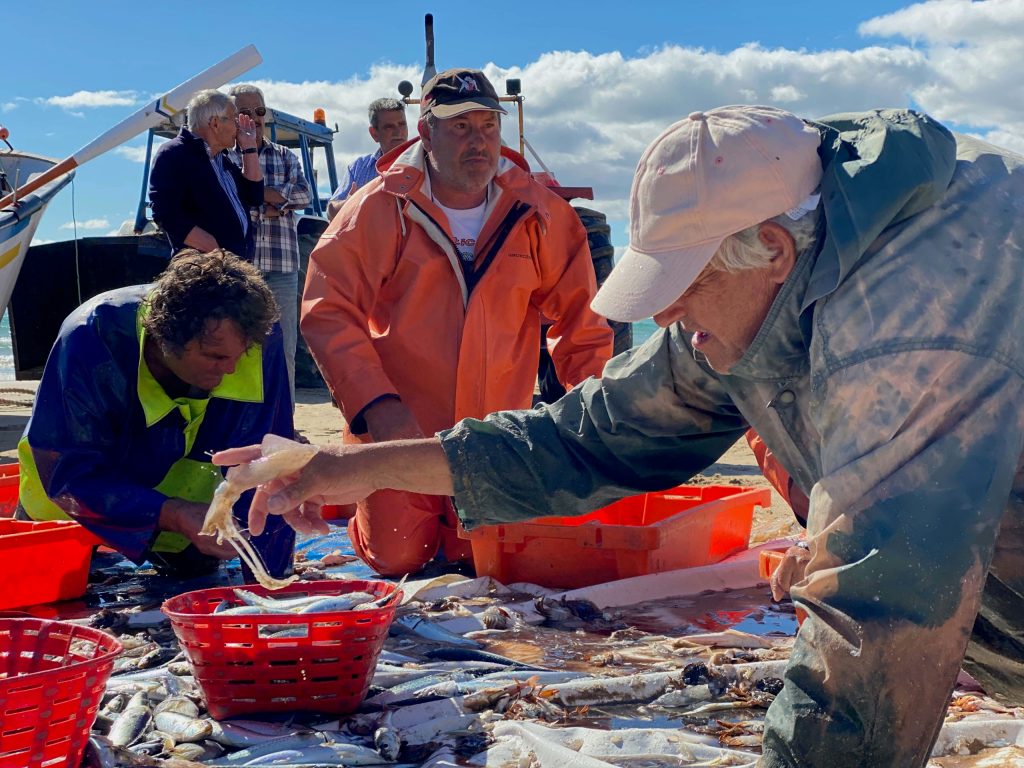
My friend Angelo (at the center) in of one his work days.
If you are a seafood lover, you shouldn’t miss a visit to a local market, where you’ll see from up close the many varieties of Atlantic fish and other seafood species which we eat around here, and which include:
Common fish the Portuguese love: sardines (sardinhas), horse mackerel (carapau), meager (corvina), sea bream (dourada), sole (linguado), red porgy (pargo), black scabbard (peixe-espada), bluemouth (cantarilho), wreckfish (cherne), conger (congro), John-Dory (peixe-galo), swordfish (espadarte), sea bass (robalo), red mullet (salmonete), and more.

Small squids, called ‘pontilhitas’, at one of my favorite restaurants in the Sado region (Setúbal) close to the local salt flats. Pérola da Mourisca restaurant.
Other seafood you should try in Portugal: squid (lulas), cuttlefish (choco), octopus (polvo), prawns of all sizes (gambas), crawfish (lagostins), scarlet shrimp (carabineiros), crab (sapateira), spider crab (santola), velvet crabs (navalheiras), European lobster (lavagente), gooseneck barnacles (percebes – such as the very prized percebes from Berlengas islands, off the coast of Peniche), clams (amêijoas), razor clams (lingueirão), spiny dye-murex (canilha), conch (búzios), and more.
A trip to Mercado Municipal de Peniche (R. António Conceição Bento 23A, 2520-294 Peniche), Mercado da Ribeira in Lisbon (Av. 24 de Julho 49, 1200-479 Lisbon), or the remarkable Mercado do Livramento in Setúbal (Av. Luísa Todi 163, 2900-462 Setúbal) will lay the grounds for a deep seafood exploration which we highly recommend you embark on while visiting this region of Portugal. Don’t be afraid to approach the fish selling stands and ask questions, as vendors will generally be happy to oblige and answer any doubts you may have about the local varieties of fish. But for something truly unique head to Nazaré, a seaside town otherwise famed for having the biggest waves ever surfed, and where the beach is still an open-air artisanal production plant for fish drying. Even though the fish curing industry is not as strong as it once was, you’ll still be able to see ladies dressed in traditional attire (which includes a bulky skirt with seven layers of cloth!) gutting and hanging mackerel (carapau seco) and a few other species to naturally dry under the sun. These dry fishes were once prepared in order to have food to last all winter long, when the harsh weather prevented fishermen from taking their boats into the ocean, and are now used to flavor stocks and, after being rehydrated, to create a variety of local seafood dishes.
Traditional fish dishes
Other must-try seafood dishes all over Estremadura include charcoal grills, such as the uber popular grilled sardines (sardinhas assadas) eaten in Lisbon during the St. Anthony festival in June, when the city’s central neighborhoods will be covered in a cloud of smoke, where the smell of grilled fish lingers in the air with the potential to make you hungry any time of the day. Don’t underestimate this simple dish of charcoal grilled fish with boiled potatoes and tangy roasted peppers salad (salada de pimentos), because it has even been voted as one of the Seven Wonders of Portuguese Gastronomy and, as sardines are a seasonal fish available during warmer months, Lisbonites wait all year long for sardines to be finally available, and at last set up their grills and enjoy meals outdoors while hanging out with family and friends. Pair your sardinhas assadas with a nice glass of chilled white vinho verde, and you got yourself a quintessential Lisbon experience!

‘Caldeirada’ stew
Setúbal and Sesimbra: fish villages around Lisbon to visit
Crossing the Tagus river and going to Setúbal means ordering choco frito, at least for a lot of residents of Greater Lisbon. Fried cuttlefish strips are one of the area’s most popular dishes, and in Setúbal city you’ll even be greeted by a funny statue of a cuttlefish which tourists often click their photo with, and which pays a tribute to one of the favorite species which locals enjoy breaded and deep-fried, along with fries and a refreshing salad. The district of Setúbal encompasses the city of Setúbal, but also the municipality of Sesimbra, arguably one of the Portuguese towns whose history has been the most linked to the Atlantic ocean. Travel to Sesimbra to soak up the sun at the beach, to marvel at the charming natural landscapes, but most of all to feast on seafood. Typical Sesimbra dishes include fish grills (do not miss the bifes de espadarte, that is, swordfish steaks), and also heartier recipes such as caldeirada, also known as caldeirada de Sesimbra. Caldeiradas are typical Portuguese fishermen stews, similar to the French bouillabaisse, with ingredients that can vary greatly depending on the catch of the day. Once upon a time, caldeiradas were prepared by fishing families, with scraps of fish and whatever bits and pieces they didn’t manage to sell on a given day. But currently a good caldeirada de peixe may contain delicacies such a monkfish (tamboril), European conger (safio), rayfish (raia), sardines and others, stewed in between layers of potatoes, peppers, ripe tomatoes, onions, and simple seasonings of olive oil, garlic and a little white wine to help the juices flow. Caldeirada is one of the most representative dishes of this region, and you shouldn’t definitely miss it when visiting Estremadura. If you are into this sort of flavor profile, chances are you’ll also enjoy sopa de peixe, fish soup readily available in many regional restaurants focusing on seafood.
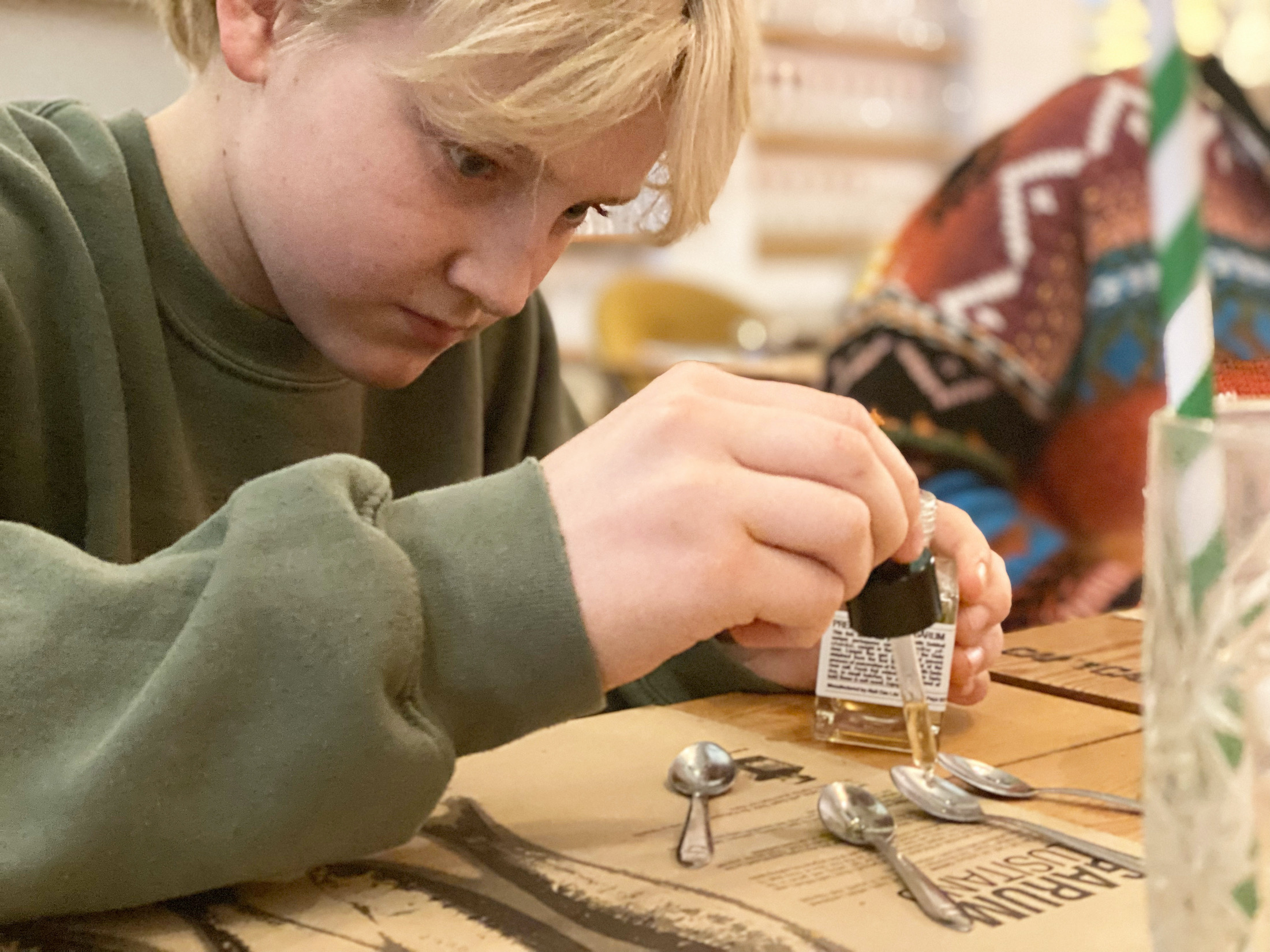
Exploring Roman Garum fish sauce during one of our food tours.
Garum sauce, a roman delicacy
We can’t stress enough how the Great Lisbon region has been defined by its proximity to the Atlantic ocean, and this is a phenomena that has been going on for millennia! Back in the days of the Roman Empire, about 2000 years ago, the walls that were used to protect the town which centuries later became Lisbon, also served to keep some space between the living areas and the massive tanks by the riverside, which were used to produce garum. Garum was a concentrated fish sauce used to add umami flavor to dishes, and which resulted from the fermentation of tiny fish, scraps and loads of salt. This pungent paste was exported across all of the Roman Empire, and enjoyed as a way to take food to the next level. Even though the production of garum eventually died and, for many centuries, it was simply not available, now-a-days near Lisbon you can again taste this powerful flavor bomb, available literally at only a couple of places, which we introduce you to during our Umami and Garum Lisbon Food Tour.
Lisbon rural influence and the importance of saloios
Fish influences aside, we should probably explore by now why the natives of Lisbon are colloquially  referred to as alfacinhas, that is, little lettuces. Around the 7th century, when the Moors from Northern Africa came to Lisbon, they started planting all-hassa (which evolved into alface, which is the Portuguese word for lettuce), a crop that thrived in the hilly neighborhoods. Soon enough the residents of this area became associated with the leafy greens, even though in later history, as the city kept growing, Lisbon started depending on the neighboring regions as a source of fresh produce.
referred to as alfacinhas, that is, little lettuces. Around the 7th century, when the Moors from Northern Africa came to Lisbon, they started planting all-hassa (which evolved into alface, which is the Portuguese word for lettuce), a crop that thrived in the hilly neighborhoods. Soon enough the residents of this area became associated with the leafy greens, even though in later history, as the city kept growing, Lisbon started depending on the neighboring regions as a source of fresh produce.
When Portugal finally became a kingdom, in the 12th century, the word saloio (which derives from the Arabic çahroi and means “inhabitant of the desert”) started being used to refer to the rural people in the areas around the capital city. Still today, we refer to the area north and northeast of Lisbon as Zona Saloia (for example around Mafra and Torres Vedras, but not only), and it’s precisely from the Zona Saloia lands which a lot of the food which was and still is consumed in Lisbon is cultivated.
Of course the Zona Saloia wasn’t only a source of fruits and vegetables, and it also has its own regional specialties. In Mafra, for example, we can taste one of Portugal’s favorite breads, pão de Mafra (also known as pão saloio), robust elongated loafs made with a blend of wheat and rye flours. In Malveira, which belongs to Mafra, do not miss out on trouxas da Malveira, spongy sweet rolls filled with velvety egg jam.
Much more than pastel de nata!
A little to the north of Mafra, there’s the city of Torres Vedras, known for its strong agricultural and wine growing traditions, but also as the birthplace of pastéis de feijão, yet another example of Portuguese conventual sweets making. These sweet bean pastries are one of the most surprising cake recipes from Portugal, featuring a smooth filling of mashed white beans, egg yolks, sugar and ground almonds in a crispy pastry casing. You can find pastéis de feijão in bakeries a little all over Portugal, but it’s only in and around Torres Vedras where you’ll be able to taste them directly from one of the 30 producers that make them with the IGP label which controls the origin and methods of production of one of Portugal’s most cherished sweet recipes.
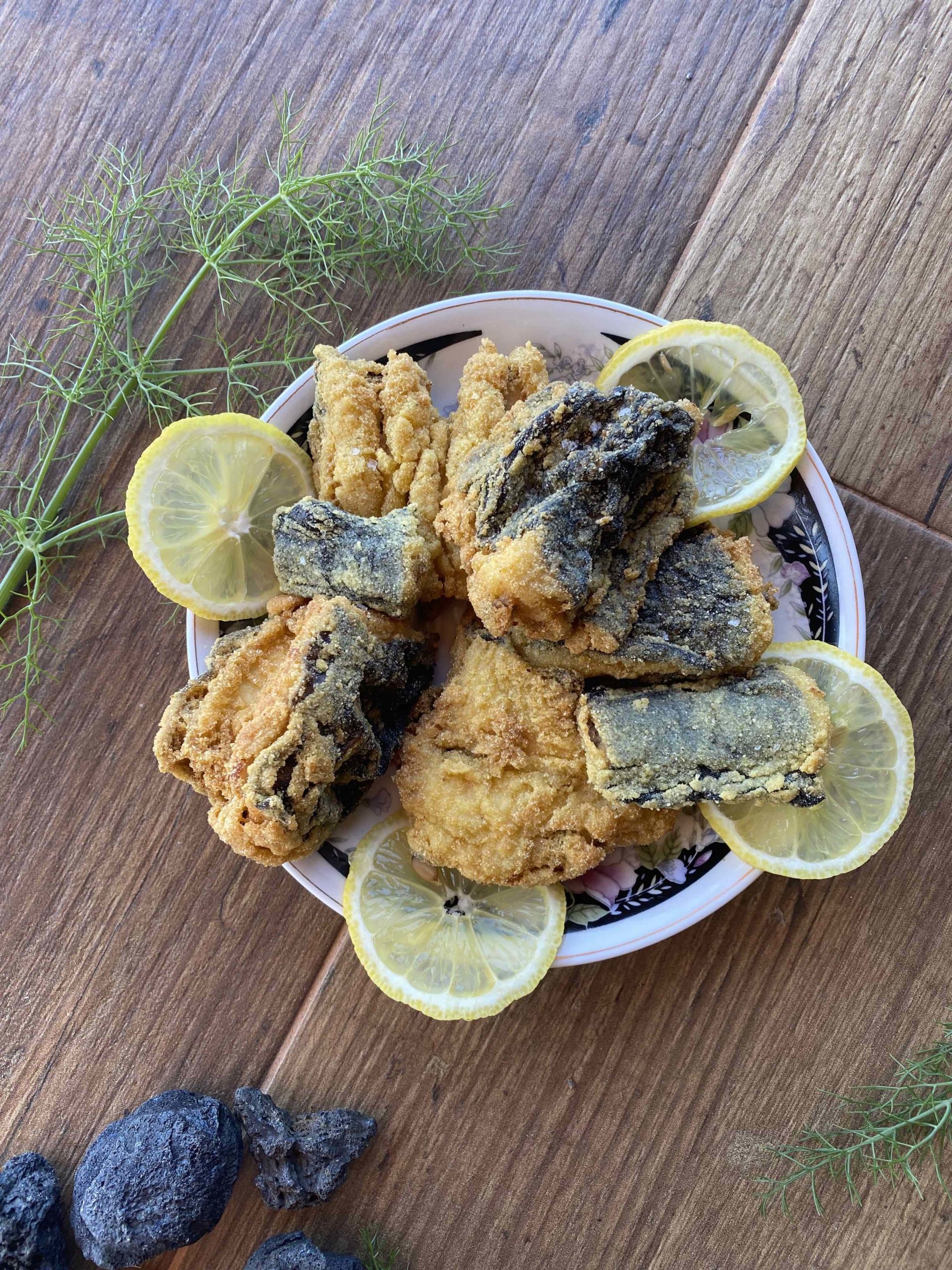
Fried moray eel, fished and cooked by Natacha Dias.
If you are basing yourself in Lisbon when you visit this region of Portugal, there are several day trips which we would recommend for the sake of trying new foods. Sintra, which is just about a one hour train ride away from downtown Lisbon, is popular for its monuments and historical buildings, which go as far back as the Moorish occupation. But if we concentrate on Sintra’s edible offerings instead, we’d have to mention sweet delicacies such as queijadas de Sintra and travesseiros de Sintra. Queijada is literally the Portuguese word for cheesecake, but you shouldn’t at all think of a cream cheese or baked cheesecake when picturing a queijada. Instead, these are pies prepared with cottage cheese, and so they are creamy and fairly light, at least when compared to other Portuguese sweets. Queijadas de Sintra were developed centuries ago at the Convent of Penha Longa, in Linhó – Sintra, but the recipe was modified when sugar became available in Portugal after the 15th century Columbian Exchange (before sugar cane, honey was the sweetener of choice), mixed with egg yolks, cinnamon and, of course, fresh cheese. Travesseiros de Sintra are a much more contemporary recipe developed by Casa Piriquita (R. Padarias 1 18, 2710-603 Sintra), a bakery which you can certainly go to when you visit Sintra, and consist of flakey sugary pockets stuffed with a paste of egg yolks and ground almonds.
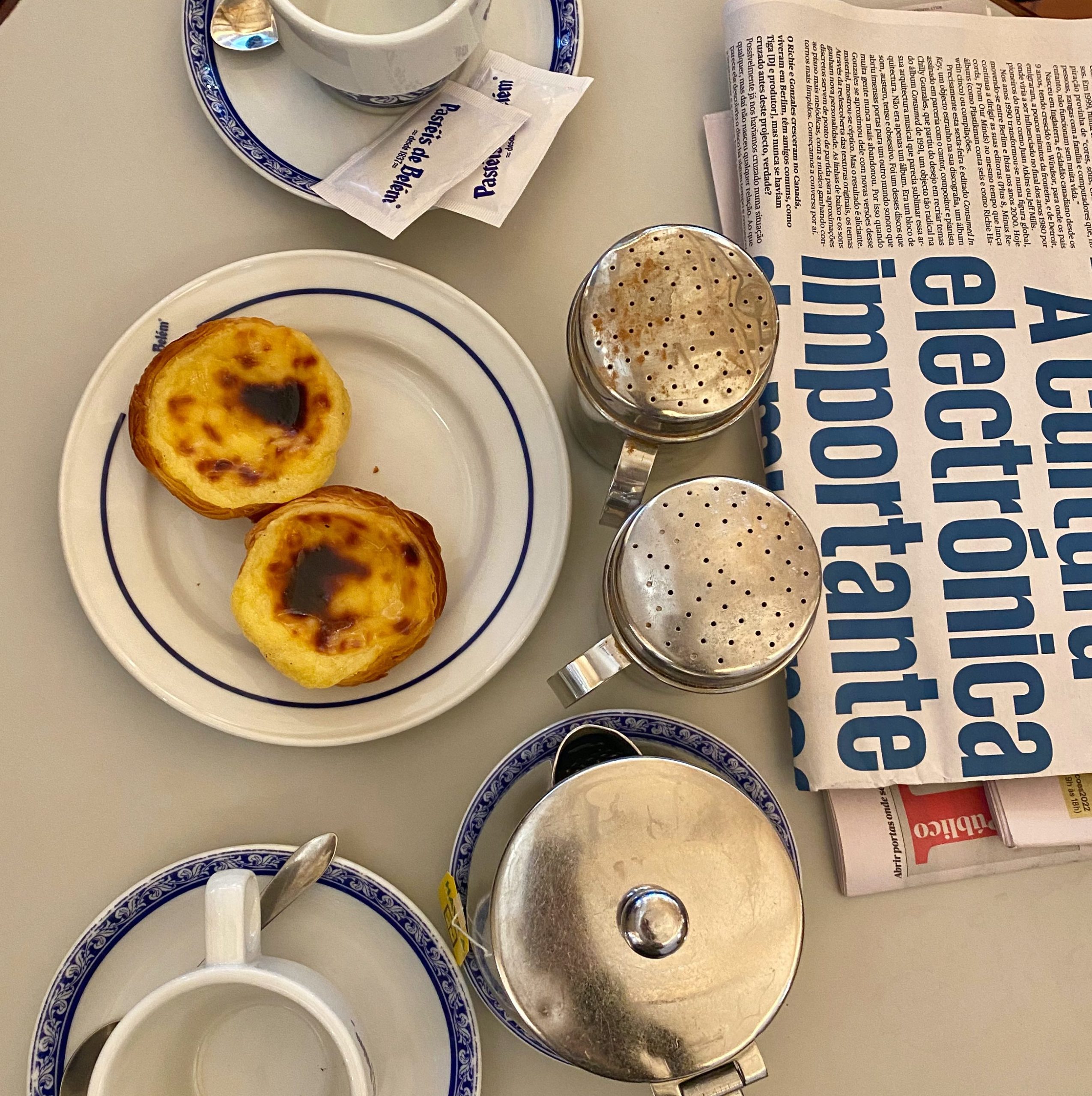
Custard cakes at Pastel de Belém bakery
Yet if there’s one food in the Estremadura region which literally takes the cake as Portugal’s most iconic sweet and which has also become a symbol of Portuguese cuisine all over the world, that is pastel de nata. Much has been speculated about the true origin of pastéis de nata (pastéis is the plural of pastel – Portuguese for pastry). Many believe Antiga Confeitaria de Belém (R. de Belém 84 92, 1300-085 Lisbon), most popularly known simply as Pastéis de Belém, purchased the recipe which had previously been developed at the neighboring Jerónimos Monastery, and this is how pastel de nata started its climb to stardom. If there’s no doubt that this historical bakery in the Belém neighborhood of Lisbon has a lot to do with the popularization of pastéis de Belém (which are here trademarked and so they are everywhere else known as pastéis de nata), the recipe is believed to have originated before the residents of Mosteiro dos Jerónimos had anything to do with it. Similar cakes to pastel de nata were already being prepared in places like the Alentejo, yet under the name queijada de nata. If we look at the elements which make a pastel de nata, they are basically a custard filling wrapped in puff pastry. Now, puff pastry was only introduced to Portugal in the 19th century, at a time when France was the main influence in European elevated cuisine, and so it’s safe to assume that the actual recipe for what we now-a-days know as a pastel de nata (or Portuguese custard tart) has evolved and mutated over the centuries. Today, you can enjoy a fresh out of the oven pastel de nata not only in Belém, but in incredible bakeries all over Lisbon, which add their own little twists, which can involve making the dough laminations with either margarine, butter, a mix of these fats or even a certain percentage of pork lard, as well as subtly infusing the custard with flavors such as those of citrus, cinnamon or both. If you think chances are you’ll miss Portuguese custard tarts when you’re back home (and we bet you will!), sign-up for a pastel de nata workshop in Lisbon, and learn how to easily make your own from scratch!
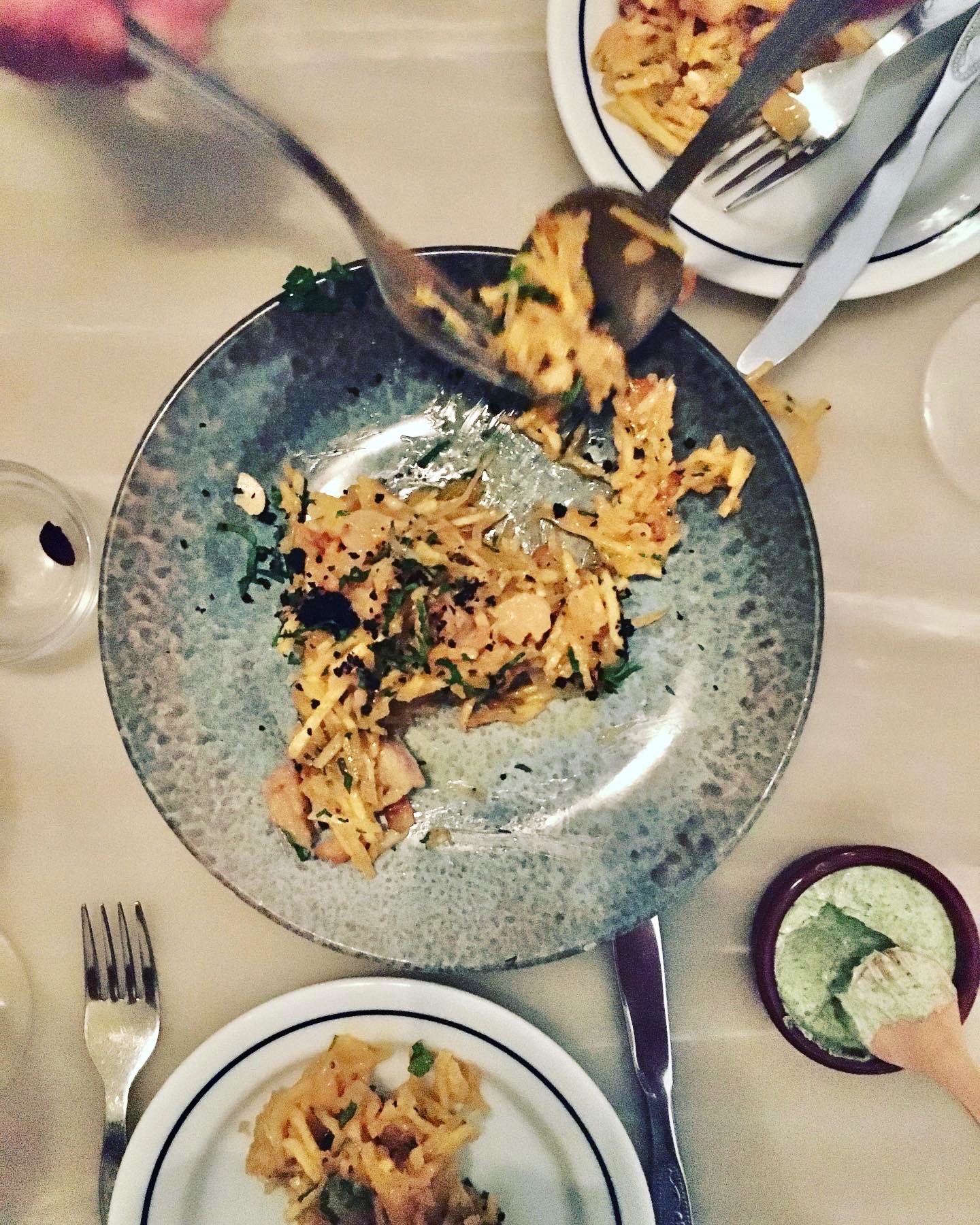
Smoked ‘Bacalhau à Brás’ at Taberna da Rua das Flores (Lisbon)
Lisbon’s petiscos and the bohemian life
Being the capital of the country, Lisbon is a city where the culinary traditions from all over Portugal converge, and even though here you’ll be able to find foods from all across the national map (and even incredible restaurants dedicated to the cuisine of Portugal’s former colonies – some of which we explore during Oh! My Cod’s Original Lisbon Food & Wine Tour to precisely investigate how cuisine, same as a culture as a whole, in an ever changing concept in constant mutation), Lisbon also has its very own local dishes. Because Lisbon couldn’t probably be Portugal’s main city without at least a couple of typical salted cod dishes (note that, prior to cooking, dry cod is always rehydrated and desalted by soaking it in water at least overnight), we introduce you to bacalhau à Brás – see our recipe for it here! This is a dish of shredded cod, onions and fried matchstick potatoes scrambled with eggs and garnished with fresh herbs and olives, which was invented in the happening neighborhood of Bairro Alto, and which has become one of the country’s favorite bacalhau dishes. Along with Brás style cod, pataniscas de bacalhau are probably Lisbon’s most iconic salted cod dishes. Pataniscas are flat cod fritters which, unlike pastéis de bacalhau, do not involve mashed potato, but are rather prepared with a flour based batter. Pataniscas can be eaten as a main meal, with a side of rice and salad, or nibbled on as a petisco.
The history of petiscos and small plates has a lot to do with the history of Lisbon’s eateries and taverns. Prior to the existence of proper restaurants, folks would head out to drink. As establishment owners saw those downing wines and other liquor could use a bite to soak up the alcohol, they started introducing small dishes (aka petiscos, in Portuguese) and so this is how a lot of Portuguese tapas came into existence, popularizing the art of petiscar in Lisbon and, as time went by and trends spread, all over the country. The first taverns opened their doors in Lisbon during the second half of the 19th century – first as places where wine was sold to take home, later on where you could come to drink with company and, eventually, where you’d also be able to grab a bite. Most of all, taverns were a place where locals and passing by travelers (such as those dedicated to itinerant commerce) would come to socialize. Meanwhile, casas de pasto also became common, first as a place where nomadic workers such as those who’d come to sell their products at local fairs would leave their animals to be fed and, in time, where also the actual animal owners would be served simple meals. One thing was common to taverns (known in Portuguese as tabernas or tascas) and casas de pasto: drinks were a given! And so these establishments quickly came to be associated with a certain bohemian lifestyle and even the beginnings of Lisbon’s most traditional music genre, fado.
Well-liked local petiscos you can try in and around Lisbon include iscas (liver cooked with olive oil and garlic, also eaten as a main meal with potatoes, under the name iscas com elas); meia desfeita de bacalhau (a shredded cod and chickpeas salad); ameijoas à Bulhão Pato (tangy clams with coriander), baby mackerel and other seafood such as mussels in escabeche (a vinegar based sauce used to marinate seafood, which comes from the Arabic al-sikbaj, which is a sweet and sour meat dish); pica-pau (chunks of meat in beer sauce, served with pickled vegetables); moelas (stewed chicken gizzards in a tomato based sauce), and peixinhos da horta (battered and deep-fried green beans, which are believed to the precursor of Japanese tempura, after the Portuguese reached Hiroshima in the 16th century).
 The Great Lisbon area’s dining scene is a representation of how Portugal, being the geographically small country that is it, is all connected. Many of the traditional eateries you still come across in Lisbon are owned by people from the Minho region, and even emigrants who came over from Spanish Galicia, mostly during the 19th century.
The Great Lisbon area’s dining scene is a representation of how Portugal, being the geographically small country that is it, is all connected. Many of the traditional eateries you still come across in Lisbon are owned by people from the Minho region, and even emigrants who came over from Spanish Galicia, mostly during the 19th century.
But, as we always say, do make it a point to head out of Lisbon during your travels! Crossing the Tagus river, you can go explore the Peninsula of Setúbal, one of the places where the Portuguese seafood canning industry started in the 19th century, and which translated into the availability of incredibly high quality tinned fish (conservas de peixe) you can now find a little all over Portugal, and which can make such an interesting souvenir to take with you.
Portuguese Azeitão DOP Cheese
Cheese from Azeitão, referred to in Portuguese as queijo de Azeitão, is by far this region ‘s favorite cheese. This sheep milk cheese has its true origins in the Beira Baixa, where Serra da Estrela cheese comes from. It was thanks to farmer and Beiras immigrant Gaspar Henriques de Paiva which we now can enjoy sharp and buttery Azeitão cheese – he used to miss the cheese from his region so much that he brought over a Bordaleira breed sheep, to start producing cheese like he used to do back home. Even though the sheep and the cheesemaking process were and still are similar, queijo de Azeitão and queijo da Serra da Estrela are different, as their terroir assigns them distinct characteristics.
Exclusive local Lisbon wines and liqueurs
The Peninsula de Setúbal is also popular as a winegrowing region, with the particularly celebrated dessert wines Moscatel Setúbal and Moscatel Roxo – if you try Moscatel do Douro when visiting northern Portugal, make sure you also try Moscatel from Setúbal, and see if you are able to taste the differences! And if you like sweet fortified wines, you should definitely look into the rare vinho de Carcavelos, a nutty and deeply flavored fortified wine produced near Oeiras and Cascais. Because of urban development, the lands once dedicated to vineyards are now very reduced, and thus Carcavelos wine is becoming increasingly rare.
Even though often overseen in favor of other beverages, namely those from the Setúbal peninsula, the neighboring region of Alentejo or even Douro wines, Lisbon has its own official wine region, made up of nine different designations of origin. Vinhos de Lisboa tend to be affordable table wines best enjoyed with meals. And speaking about meals, do what many visitors to Lisbon do, and enjoy a ginjinha (a sour cherry liqueur also known as licor de ginja, typical from Óbidos but available all over Lisbon) for a sweet ending. Fancy something stronger? Ask for a brandy from Lourinhã, popularly referred to as lourinhac!
Ribatejo: rural way of life and countryside style dishes
What to eat in Santarém and beyond ?
Ribatejo is an area influenced by the regions it shares its borders with (Lisbon’s Metropolitan Area and Estremadura to the west, Beiras to the north and Alentejo to the west and south), but more than anything its way of life has historically been shaped by the Tagus river – the province’s name literally translates as “above the Tagus riverbank”. This is a region with a lifestyle defined by pastoral heritage, wine production and agricultural lands where it’s not at all uncommon to see horses grazing.
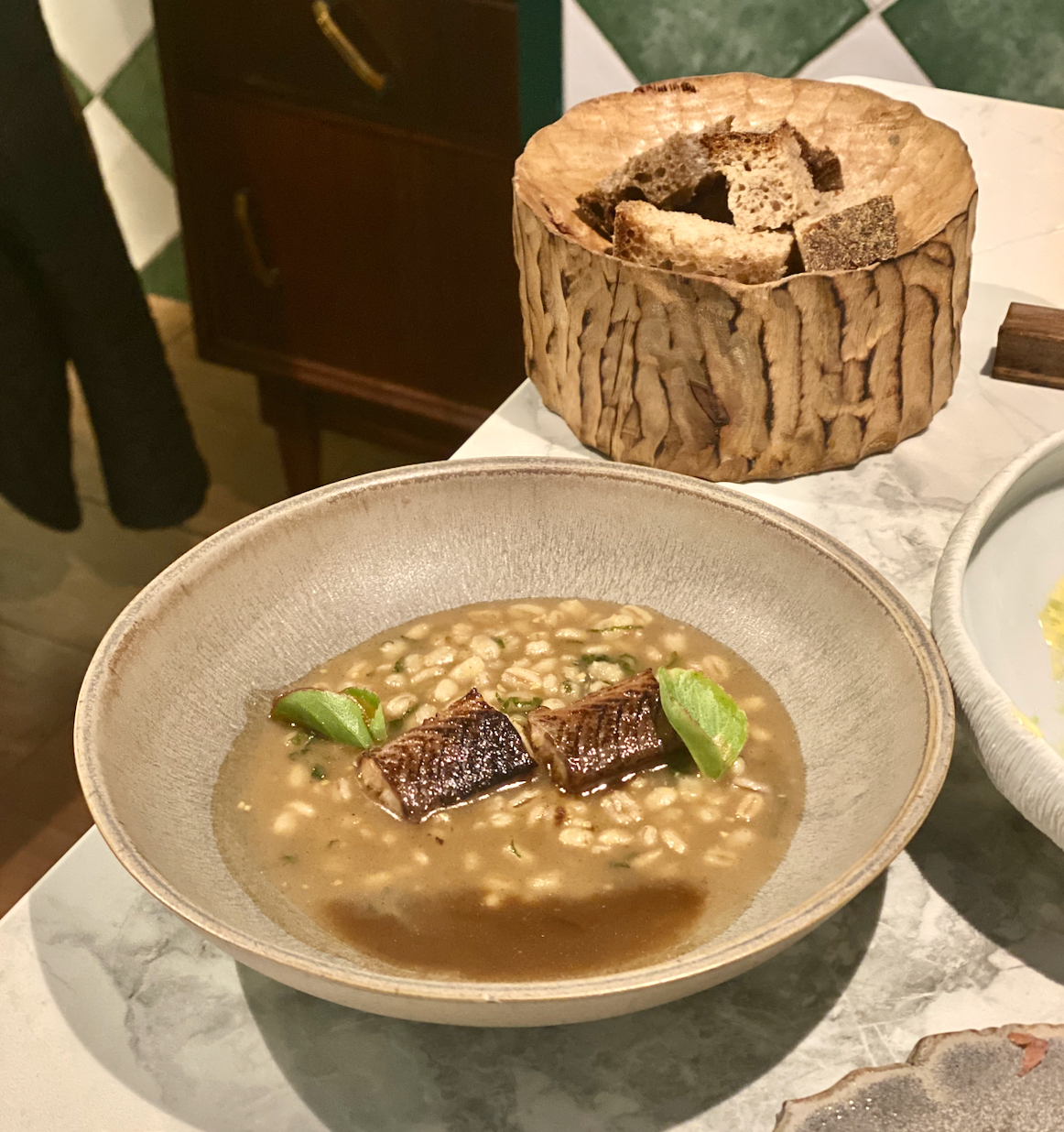
If you travel to Santarém, don’t miss Chef Rodrigo restaurant, ‘O Balcão’. A delicious celebration of local river fish. Here, faked ‘cabidela’ with barley and smoked eel.
Ribatejo’s main city, Santarém, hosts a yearly food festival called Festival Nacional de Gastronomia, which has been taking place for over four decades. If you are traveling to Portugal during November, this food fest can be a brilliant kickoff for your food explorations not only of the Ribatejo region, but of Portugal’s cuisine as a whole.
Starting with Ribatejo sweets!
Santarém itself is synonymous with pampilhos, cone shaped confections filled with egg yolk cream and cinnamon, and which are a tribute to shepherds’ crooks. Unlike other Portuguese sweets, which tend to have their origins in ancient religious organizations, pampilhos were developed by Pastelaria Bijou (R. Capelo e Ivens 135, 2005-155 Santarém) only about a half a century ago, and were later trademarked in the 80s. While similar recipes are available in other bakeries these days, many Portuguese folks do a detour when in the area, for the sake of trying the original pampilhos. While road-tripping in the area, but only during the summer months, you’ll probably also come across road-side stands selling local fruits which are grown in the scenic landscapes of this region, and which include a local variety of white melon which is very sweet and aromatic, known as melão branco do Ribatejo.
River fish, Carolino rice and bread
As the Ribatejo is close to the ocean but doesn’t have direct access to it, it has historically made the most of its location by the river, whose fertile swampy lands are known in Portuguese as lezírias (from the Arabic al-jazira, or islands). The typical postcard image of the Ribatejo would involve the lezíria with grazing horses and bulls, in a land where bull fights not only still exist but are surprisingly until now quite popular. The riverbanks explain one of the Ribatejo’s most iconic dishes, sável frito, that is, fried allis shad fish. Even though this fish which is a part of the herring family comes from the North Atlantic, it chooses places like the estuary of the Tagus river to spawn, and so the people of the Ribatejo have made the most of the opportunity which brings the Atlantic a little closer to them. Besides fried allis shad, this fish is also enjoyed as açorda de sável, a savory porridge made of bread softened with fish stock, or even as fried sável served with açorda prepared with the fish roe (açorda de ovas).
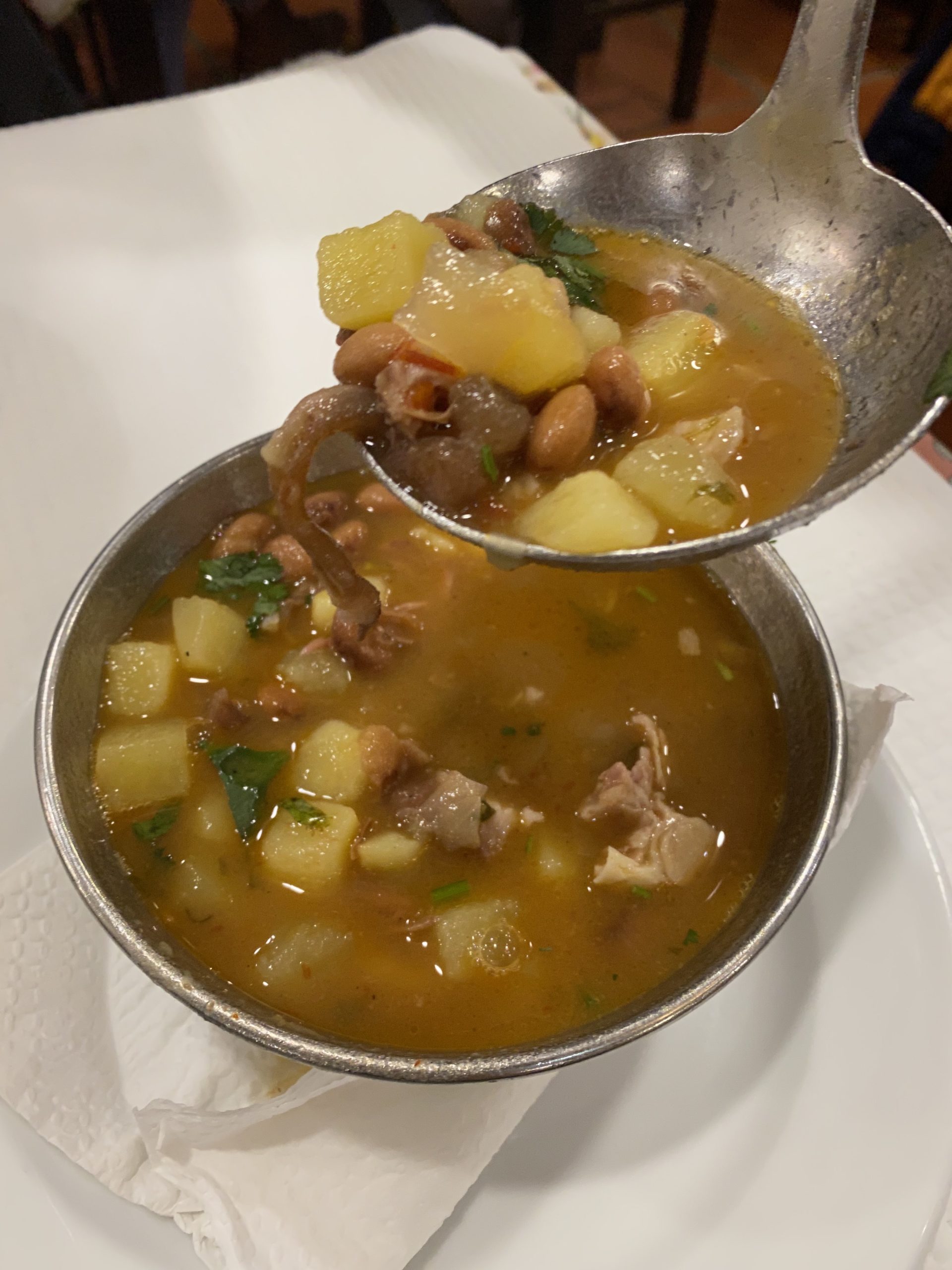
‘Sopa da Pedra’ at Almeirin, O Forno restaurant. Delicious and they will serve you enough to bring some home!
It’s precisely in the lezíria Ribatejana where Portugal grows its main variety of rice, arroz Carolino, a product with protected geographical indication by the European Union since 2008. This white long grain, whose starch and powers of absorption make it ideal for dishes which involve a considerable amount of stock (similar to risottos), is cultivated in an area called Baixo-Mondego, and it’s essential for typical dishes all over the country, turning Portugal into the largest consumer of rice in Europe!
Bread is a major staple carbohydrate of the Ribatejo, because of being an easy to transport and store food, which would guarantee sustenance for peasants who’d back in the day pack a lunch for their day out working in the fields. Recipes such as torricado came about from the need to repurposing hard bread. Torricados are Ribatejo’s take on toasted bread with various toppings, as an open sandwich of sorts. Torricado de bacalhau is one of the most popular ones, and consists of bread traditionally heated over coils, rubbed with olive oil and garlic, and topped with shreds of salted cod. This is a delectable petisco you can enjoy as a snack with a glass of wine anytime of the day, or as an appetizer prior to a heavier traditional Ribatejo meal.
Hearty dishes from the Ribatejo region
Servings of food from the Ribatejo reflect the local agricultural and cattle farming lifestyle. Sopa da pedra, a recipe developed in Almeirim, is a Portuguese recipe which defies the borders between soup and stew. It consists of an amalgamation of potatoes, vegetables, different cuts of cured meats and red beans, which together in a bowl embody Portuguese comfort food at its best.
Ribatejo is also the region to try braised dishes and stews such as caldeirada de bacalhau (salted cod stewed with potatoes and vegetables), ensopado de enguias (eels stew, just like around Aveiro), favas com chouriço (broad beans and chorizo stew), ovos de tomatada (eggs poached in tomato sauce, somehow similar to Israeli shakshuka), or molhinhos de carneiro com grão (ram stomach and chickpeas stew).
Tejo wine region
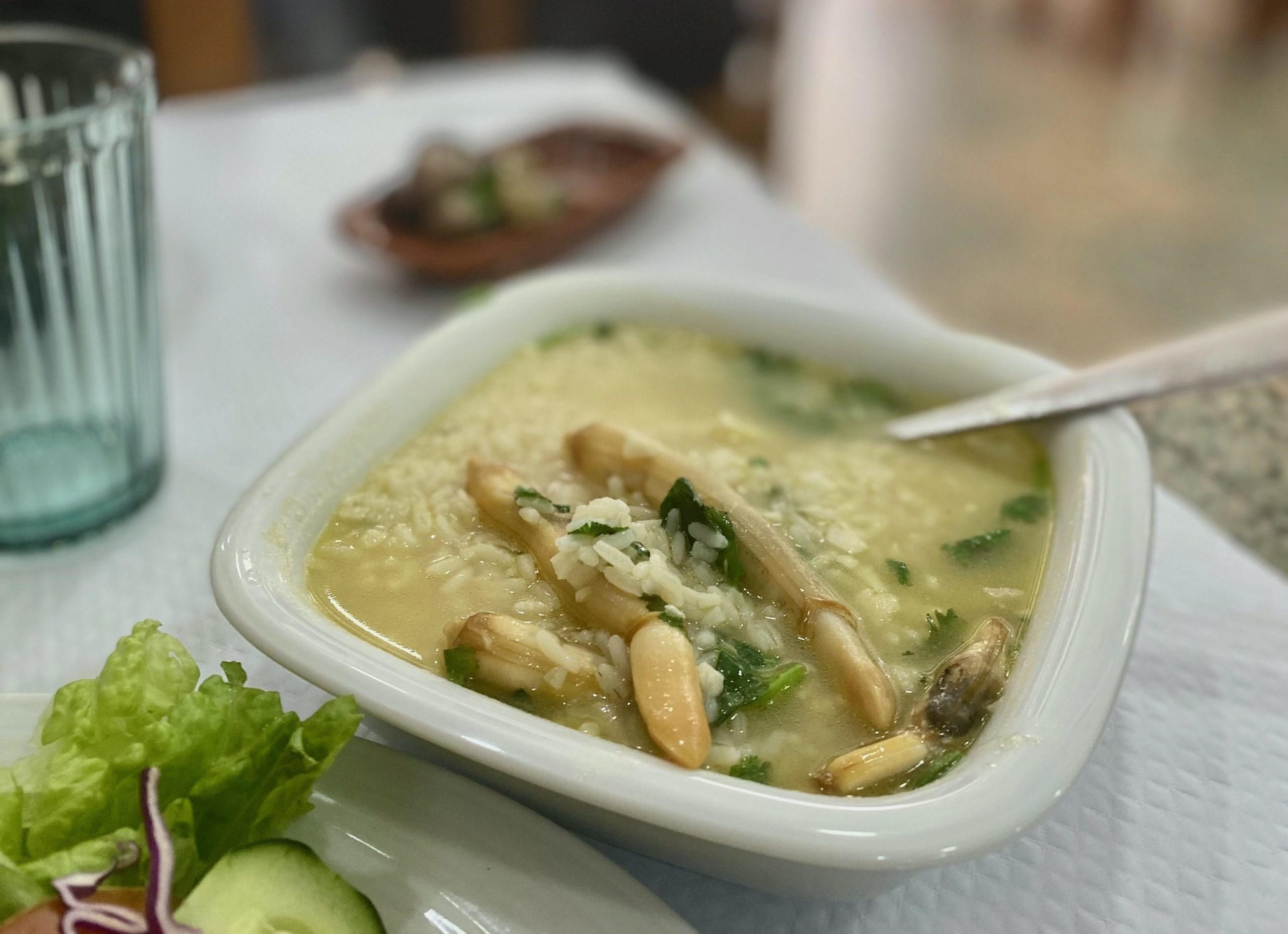
Razor clam rice near Alcácer do Sal.
Briefly looking into the world of wines in the Ribatejo, we’d have to talk about the Vinhos do Tejo wine region, with a well defined terroir influenced by the salty breeze of the Atlantic to the west, and the hilly Serra de Aires e Candeeiros to the east. Amongst the many wines grown in the Ribatejo, the ones from Cartaxo are some of the most popular, so if you’re a wine connoisseur, a visit to the Cartaxo Wine Cooperative may be on the cards during your trip.
You are probably going to enjoy several meals out during your stay in Portugal, so take them as an opportunity to order wines from different Portuguese regions, and get acquainted with the bounty of our country!
Itinerary overview for a food trip in the Greater Lisbon and surrounding areas
Most characteristic places you should visit:
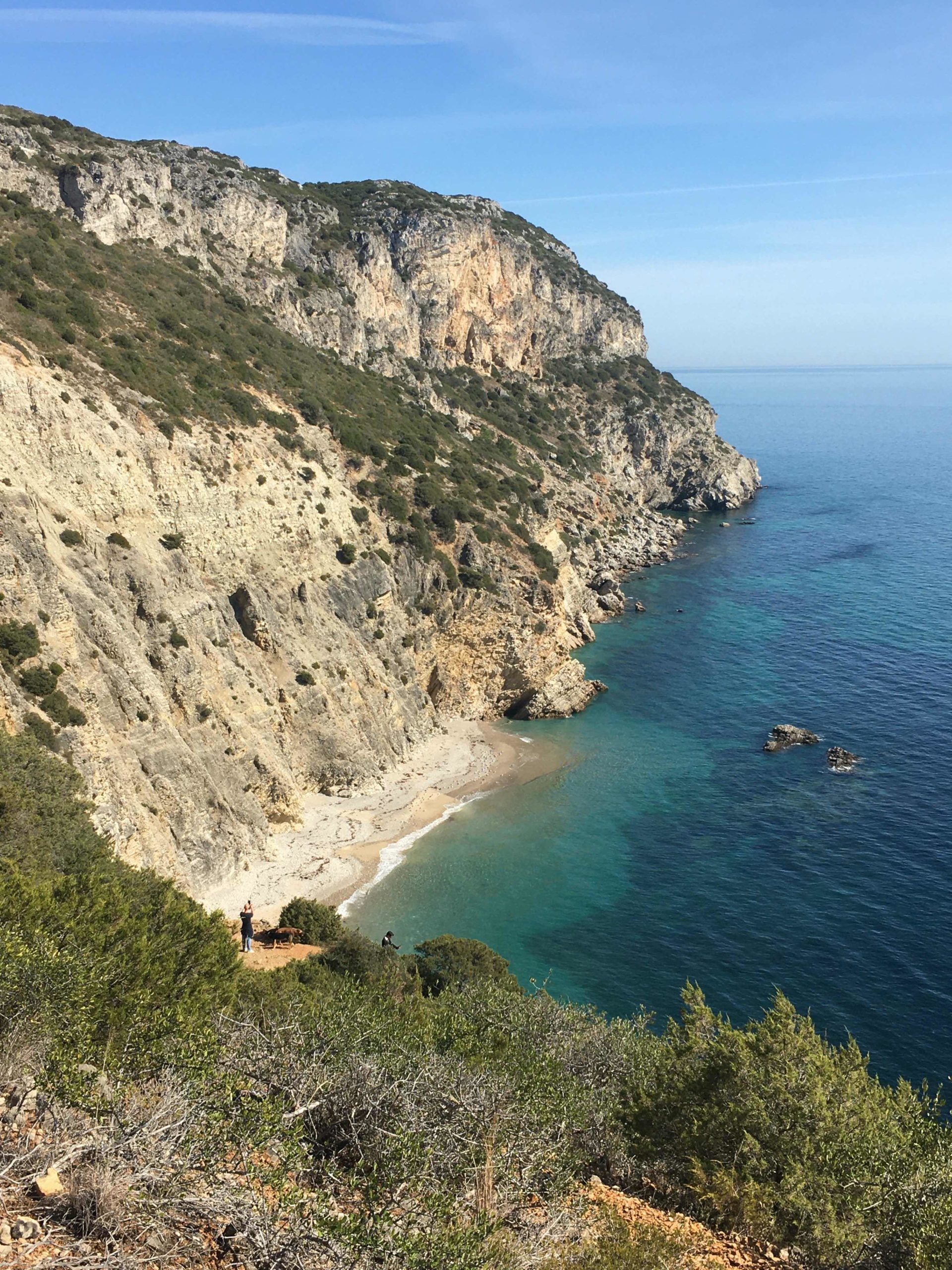
Arrabida is amazing for trekking. Download the AllTrails application and follow the locals trails. Here, we were descending to ‘The hell beach’. After a diabolic descent you find heaven.
- Nazaré
- Óbidos
- Peniche
- Mafra
- Lisbon
- Cascais
- Sintra
- Palmela
- Sesimbra
- Setúbal
- Alcácer do Sal
- Santarém
- Golegã
- Moita
Must-eat traditional dishes:
-
- Grilled fish (especially sardines in the summer
- All things seafood (particularly goose barnacles from Berlengas)
- Pão de Mafra
- Pastel de feijão
- Bacalhau à Brás
- Ameijoas à Bulhão Pato
- Pastéis de Belém
- Travesseiros de Sintra
- Pampilhos from Santarém
- Choco frito
- Sopa da pedra
- Azeitão DOP cheese
Typical drinks to try:
- Ginjinha
- Wine from the Setúbal Peninsula (particularly Moscatel)
- Carcavelos fortified wine
- Table wines from the Lisbon and Tejo wine regions
Off-the beaten path culinary treasures:
- Visit the smallest wine region of Portugal near Oeiras, and try the rare Carcavelos wine;
- Make friends with the folks of Confraria da Caneja in Ericeira, and see if you can get invited to eat with them one of the stinkiest (and rarest!) dishes you’ll find in Portugal – caneja d’infundice is a type of small shark which is left to ferment underground for a couple of weeks, before it’s eaten boiled with potatoes (an experience not recommended for picky eaters or the faint of heart);
- Invite your new friends to visit the Rice Museum of Comporta with you – which only opens its door for groups of 10 people and above!
-

Take a cab or a bus to Costa da Caparica and assist to fisherman rotine at the end of the day. Personally, it’s where we go to buy fresh fishto prepare ceviches or even sashimis.
Article by :
Zara Quiroga (freelance food writer and food & cultural leader at Oh! My Cod Pico Trips)
Photos by:
Sílvia Olivença (anthropologist and food guide/CEO at Oh! My Cod Ethnographic Food Tours & Trips)
Want to more about Portuguese cuisine?
Alentejo and Algarve: culinary traditions of the South of Portugal
Pico Wine: one of the world’s most unique wine regions (Genesis – Part I)
